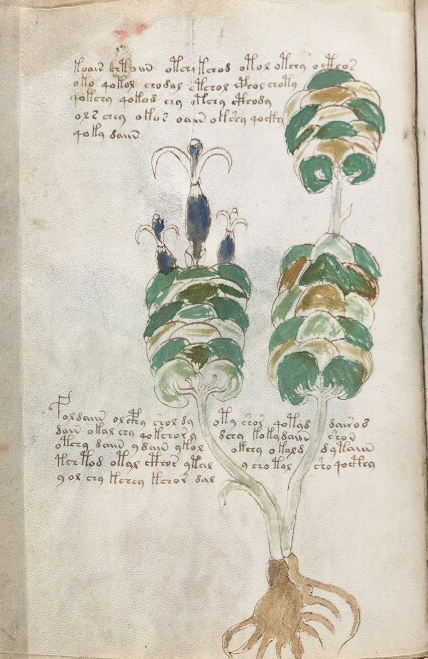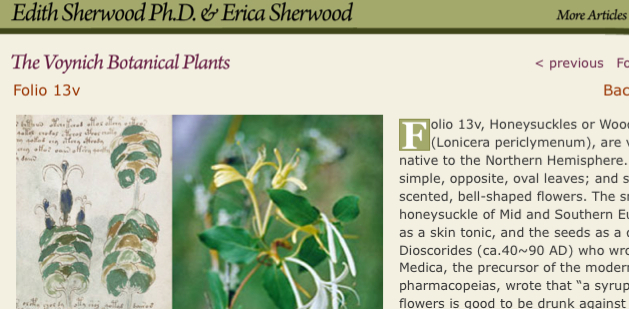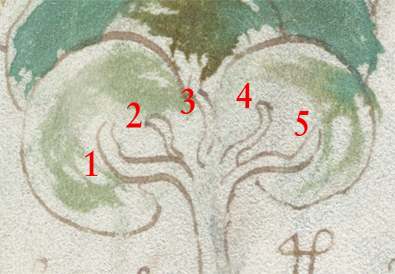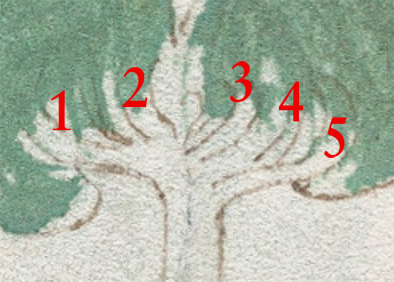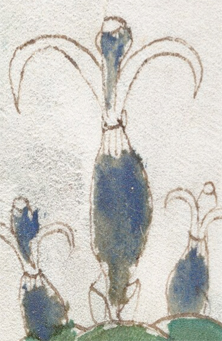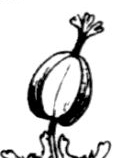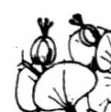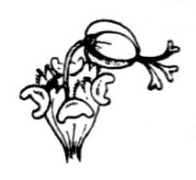Plant 13v covers most of the page from the upper text block to the bottom edge, but isn’t as wide as some of the other large plants.
There are two widely separated text blocks, and the bottom block breaks across the plant stalks in two places.
The drawing appears to represent two closely associated plants, the stems are arising from separate tubers, one behind the other. The tubers are rounded, somewhat onion-shaped, with fairly thick, short side roots. The stalk curves a little and has the occasional leaflet or bract.
The leaves are arranged in pairs and densely clustered. The attachment between the stem and leaves suggests this is a branching plant. Note that it branches five times. The leaves have been painted brown, light brown, green, and light green, probably to distinguish individual leaves in a thick cluster or otherwise in close association with each other, as has been done in some of the other drawings.
The plant on the right has a second stalk or runner leading to another dense clump of leaves, which makes it hard to tell, without further study, whether this is an upright plant or a trailing vine. The plant on the right has no flowers.
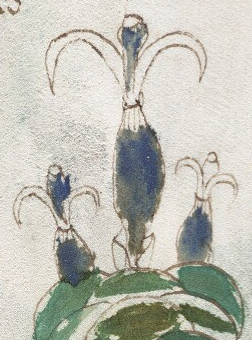 The plant on the left has, at its end, flower heads that extend from behind the three end leaf pairs. There there is a pair of leaflet-shapes or a claw shape at the base of the center flower head that has not been painted green (and may be something other than leaflets).
The plant on the left has, at its end, flower heads that extend from behind the three end leaf pairs. There there is a pair of leaflet-shapes or a claw shape at the base of the center flower head that has not been painted green (and may be something other than leaflets).
The flower heads on the sides don’t protrude as far as the one in the center, so it can’t be seen from this angle whether they too have petals/bracts/leaflets between the flower head and the end leaves but it’s probable that their shape mimics that of the central flowerhead.
Prior Identification
Edith Sherwood has identified Plant 13v as Lonicera periclymenum (Honeysuckle) even though few of the structural details are the same as 13v. Here are some of the ways in which L. periclymenum differs from the VM plant:
- L. periclymenum leaves have longer tips, are not rounded and don’t grow in dense clumps. They tend to be more evenly spaced along the vine.
- L. periclymenum doesn’t have a vase-like structure where the blossoms connect to the stem, as is seen in 13v.
- L. periclymenum has reddish and yellowish blossoms, but the VM illlustrator chose blue for the main part of the flower head, even though a reddish pigment (or at least a brown pigment) was available to the VM illustrator.
- L. periclymenum roots are more slender or stringy, rather than roughly onion-shaped.
- L. periclymenum does not specifically branch in five directions at the stem node as shown on both plants in 13v.
It’s true that L. periclymenum leaves sometimes have a “fused” appearance where the flowers come out of what appears as “Siamese leaves” (e.g., L. Sempervirens) but the similarities to 13v in other respects aren’t sufficient to make L. periclymenum a good candidate.
Other Possibilities
Some VM plants are more difficult to identify than others. The illustrator was somewhat scientific in approach, interested in portraying details, but was clearly not a professional artist and shows a certain “impatience” or haste in filling in the colors in the plants. Nevertheless, there are good reasons to believe that Plant 13v may be a species of Euphorbia.
The most distinctive features of Plant 13v are 1) the rounded root, 2) the dense association of the leaf shapes, 3) the vase-shaped flower heads with protrusions reminiscent of a snake’s tongue, 4) a stem that branches in five directions, and 5) the fact that two plants, one with flowers, one without, have been drawn together. That the rightmost plant has a double stalk or perhaps a runner should also be considered.
These features are found to a greater or lesser extent in a number of Euphorbias.
Euphorbia is an extremely diverse species. Many closely related Euphorbias don’t resemble each other at all. They range from large multi-limbed cacti, to small star-leaved groundcovers. Some even look like pineapples, with a round scaly clump that resembles a soccer ball waiting to be kicked. Even the tiny spotted spurge that creeps along driveways and lanes is a species of Euphorbia. Not all Euphorbias have rounded tubers. Many have medium- to fine-texture tap roots.
Thus, it’s important to focus on Euphorbias with characteristics similar to 13v, such as Euphorbia apios, a small Mediterranean plant with tubers that resemble lumpy turnips. Euphorbia helioscopia is a common variety with similarities to E. apios, but the root is rarely rounded—it is more of a tap root.
E. apios was historically called “wild radish” and may be the Apios ischas mentioned in Pliny’s The Natural History. E. apios throws out runners that creep along the ground. The outside of the tuber is dark, the inside lighter.
Details
Pinning down the species of Euphorbia is difficult but it might be possible to narrow them down based on some of the 13v details. For example, a number of Euphorbias specifically branch in five directions as is illustrated by the VM plant.
There are numerous Euphorbias that have the vase-like flower heads with “snake tongues” at the ends. As the season moves on, the vase-like structure becomes rounder and fuller and starts to nod, so Plant 13v may have been observed earlier in the year rather than later.The curved ends of the 13v flowerhead resemble E. helioscopius or E. cyparissias more than E. apios—the snake-tongue protrusions are more distinct than those of E. apios, but E. apios has a tuber very much like 13v.
E. apios is not a perfect match either, despite the rounded tuber. The flowerhead is quite nobby, while the flowerhead on 13v is smooth.
Not all Euphorbias have rounded leaves. Some have points at the tips and many are elliptical or lanceolate, but 13v emphasizes the rounded shape typical of a number of Euphorbias.
Whether 13v is a lesser-known species, an extinct species, or whether the VM illustrator created a picture intended to demonstrate the more common characteristics of closely related species is not clear but it seems unlikely that this is Lonicera periclymenum and more likely that it’s Euphorbia.
Posted by J.K. Petersen

